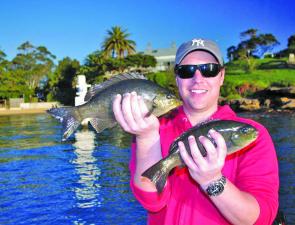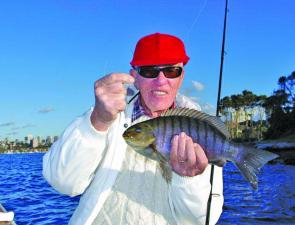The most reliable fish at this time of year are luderick. Fortunately, being primarily ocean blackfish, they will take cabbage weed, as opposed to the smaller river luderick that prefer the often hard-to-obtain river weed.
Unfortunately with all the bad weather over Winter, cabbage weed has also been sparse because the big swell smashes it off the rocks.
With a bit more effort, though, cabbage can be found on most ocean rock platforms. You’ll need a bucket of sand as well, which is mixed with some chopped cabbage weed and used for berley.
Blackfish are possibly one of the most reliable species found in Sydney Harbour. They can be successfully targeted all year round but we tend chase them more in the cooler months because our main focus in Summer is kings.
Blackfish are found throughout the system, from the Heads right through the freshwater reaches. I’ve even seen them in pure fresh water in the headwaters of Middle Harbour.
Although they are obviously exactly the same species, blackfish often get categorised into river blackfish and ocean blackfish.
River blackfish are generally smaller, darker fish found in the upper reaches. They usually don't exceed about 500g and therefore require a scaling down in tackle compared with that used to catch their much larger ocean brothers.
Rods still need to be long but are of lighter construction.
There are a couple of reasons for the long rods for blackfish.
They are required to lift the belly of line that often forms between the rod tip and the float, and they must also cushion against the fish’s numerous powerful lunges and avoid pulling the tiny hook from luderick’s small mouth.
Quill floats are far more efficient than the heavy, long-stemmed floats used for the ocean fish. A No 10 or 8 Mustad sneck hook, in green, completes the rig.
River weed, the hair-like weed found in the brackish reaches, is the preferred bait for river blackfish.
Some of the better spots in the Harbour include; Greenwich, Long Nose Point, Lane Cove River, Blues Point, Balls Head, Valentia Street wharf and the wall near Luna Park. In Middle Harbour, Roseville, Killarney Point, Spit Bridge and Beauty Point are the pick.
The lower Harbour has a number of spots that attract some quality ocean blackfish.
These fish are in the same class as the fish you would expect to find off the ocean rocks. Averaging around a kilo, they are much lighter in colour with prominent bands running down their bodies.
They are found in much rougher country so the tackle must be scaled up a bit.
Rods are slightly heavier in the butt and 4kg to 5kg line is more appropriate.
The heavier, long-stemmed floats are used and a No 8 or No 6 hook is more suited to these larger fish.
The other main difference between these ocean fish and the river fish is the cabbage weed bait.
Control of the rig can be tricky, with light floats, long drops, wind-resistant baits and lots of sinkers to demand constant attention.
The running float rig has a float that is free to run on the line, stopped below by a split shot and above by a ‘stopper' of twine or a rubber model available at most tackle stores.
The must clamp the line tightly enough to stop the float sliding any further, yet still must be loose enough to be adjustable. It must also be compact enough to go through rod guides and cast back out again without snagging.
Some anglers add a small plastic bead between stopper and float so the stopper itself stops the bead, and the bead stops at the float eye.
With this rig you can easily adjust the depth at which the hook is suspended, yet have a rig that is easy to cast.
However, it is prone to tangling because the wind resistant bait is very close to the float during the cast and can tangle around the float.
The fixed float features split shot clamped above and below the float to restrict its movement up and down the line. The float remains at the full depth you are fishing, so it’s really only suitable for depths up to a bit more than the length of the rod.
This is much less prone to tangling during the cast. This is the method I use most often because I don’t often fish at depths below about 12’.
In both rigs the float must be weighted with split shot, sinkers, strip lead around the float stem or a combination of all these so that the cork or foam section is under water, leaving just the one-third of the stem showing.
Conditions dictate the size and weight of the float. In windy, rough water you need a big, heavy float and in calm conditions a quill float is ideal.
Reel choice is up to you. Centrepins are still used as a tradition, specialist Alvey sidecasts are good but I use threadlines because as they offer frictionless casting and line feed and can quickly pick up line belly before striking.
Luderick are top eating fish if they are bled, iced, filleted and skinned. Don’t forget to remove the black lining from the stomach.
Facts
GATHER CABBAGE WHERE YE MAY
Cabbage weed, commonly found on the ocean rocks, grows in abundance on the lower reaches of the Harbour and is therefore the obvious luderick bait in those areas.
You'll have to gather your cabbage from the ocean platforms, though, because taking anything from the intertidal zone of Sydney Harbour is prohibited.
A berley consisting of chopped weed and sand is a big advantage for river and ocean fishing.

Luderick from the upper Harbour are often smaller and darker in colour than the sea-run fish.

Blackfish from the lower Harbour and the ocean rocks are more bronze, the stripes are more marked and they are genrally larger.


A typical Winter mixed bag – trevally, luderick and leatherjackets – can provide fine dining for days.

Luderick can provide a great day out on the Harbour when few other fish are co-operative.




